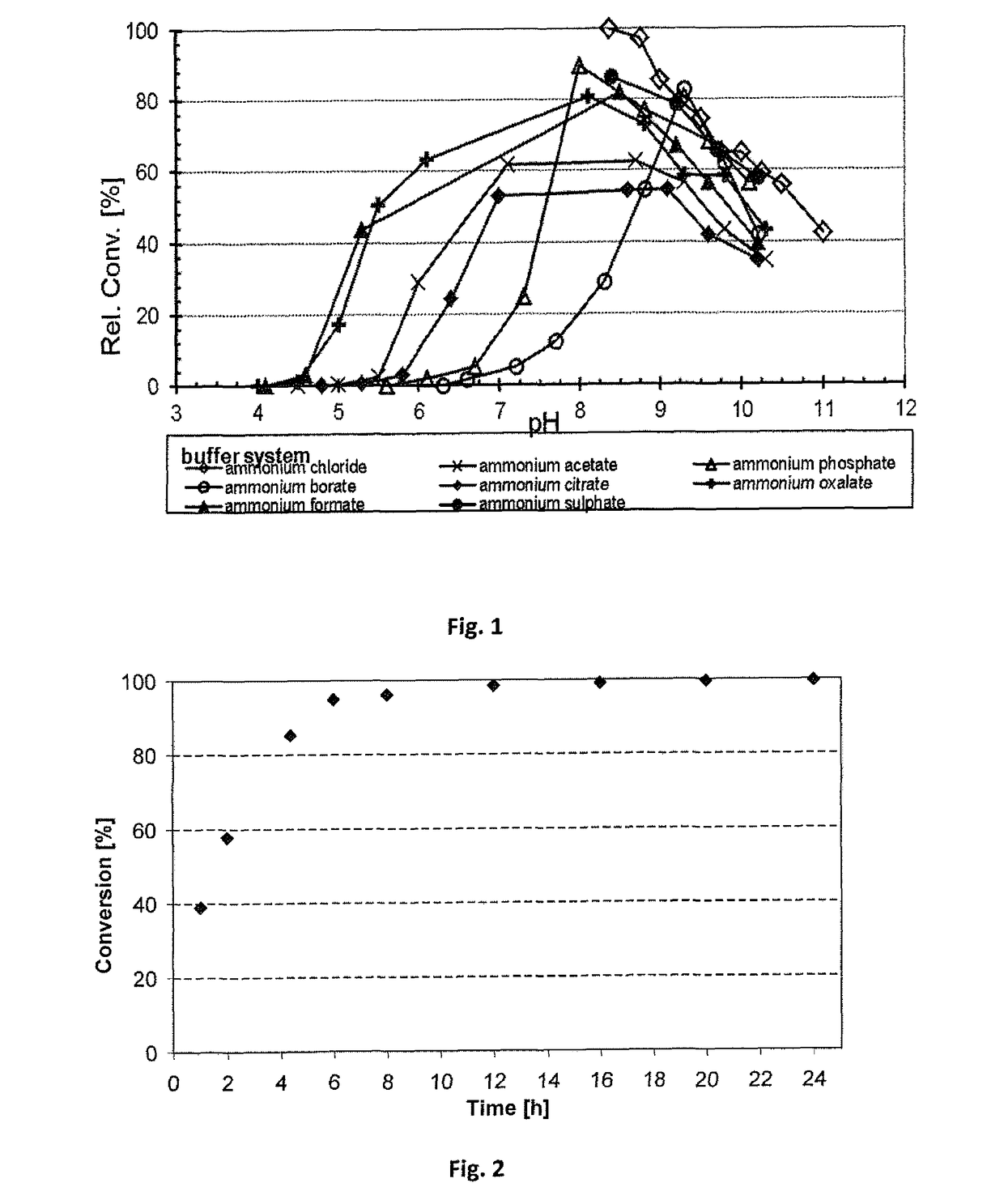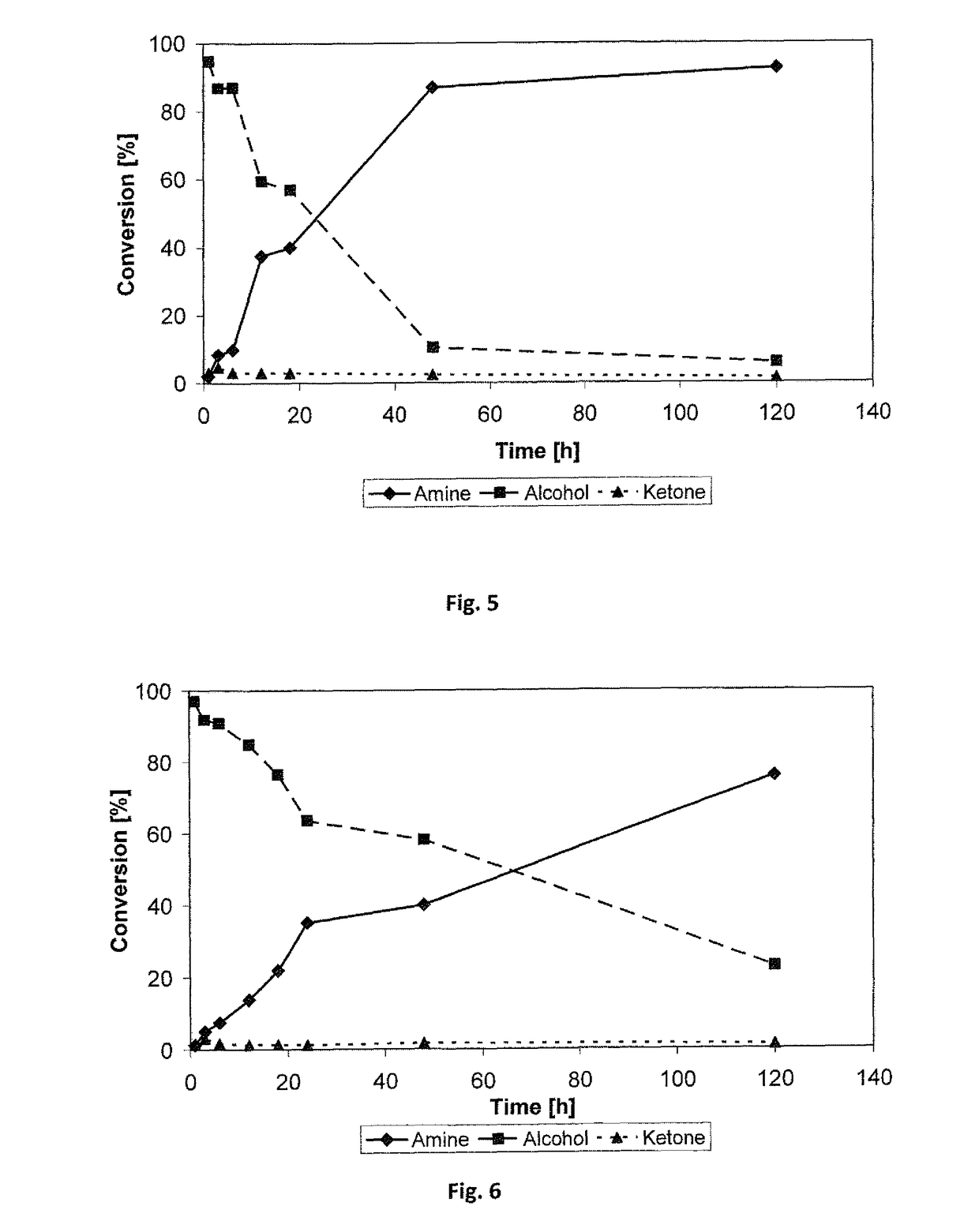Redox Self-Sufficient Biocatalytic Amination of Alcohols
a biocatalytic and self-sufficient technology, applied in the field of redox self-sufficient biocatalytic amination of alcohols, to achieve the effect of lowering environmental impact factors and increasing atom efficiency
- Summary
- Abstract
- Description
- Claims
- Application Information
AI Technical Summary
Benefits of technology
Problems solved by technology
Method used
Image
Examples
example 1
eparations
1.1 Enzymes for the Oxidative Step (Alcohol Oxidation)
[0256]The oxidative step as exemplified is performed by alcohol dehydrogenases which are NADH-dependent. NADPH-dependent alcohol dehydrogenases (ADH) cannot be applied because the coupled second reductive step of the exemplified reaction cascade is catalyzed by amine dehydrogenases (AmDH), which are strictly NADH-dependent.
[0257]The oxidation of primary alcohols is performed by a single primary alcohol dehydrogenase. Suitable primary alcohol dehydrogenases are the alcohol dehydrogenase from horse liver (HL-ADH) (a) D. H. Park, B. V. Plapp, J. Biol. Chem. 1991, 266, 13296-13302; b) S. Al-Karadaghi, E. S. Cedergren-Zeppezauer, S. Hovmoller, K. Petratos, H. Terry, K. S. Wilson, Acta Crystallogr. Sect. D 1994, 50, 793-807) or the alcohol dehydrogenase from Geobacillus stearothermophilus (ADH-hT). (a) R. Cannio, M. Rossi, S. Bartolucci, Eur. J. Biochem. 1994, 222, 345-352; b) X. Zhang, T. C. Bruice, Biochemistry 2007, 46, 83...
example 2
f-Sufficient Biocatalytic Cascade for Amination of Alcohols
[0274]The cascade depicted in Scheme 4 has been performed:
[0275]A preliminary experiment of combining the Prelog alcohol dehydrogenase ADH-‘A’ with the amine dehydrogenase Ph-AmDH was performed. The ADH-′A′ was used in the form of E. coli whole cells (ca. 10 mg whole cells) overexpressing the catalyst without any further purification. The AmDH was used as a purified enzyme (50 or 100 μL, 53 mg mL−1). The AmDH was purified as described previously. (S)-phenyl 2-propanol (20 mM) was used as the test substrate. The reaction was run in ammonia / ammonium chloride buffer (1 mL, 240 mM, pH 9.6), prepared as previously described. Catalytic amount of cofactor NAD+ was used (1 mM). The reaction was shaken at 30° C., for 1 day, in an orbital shaker at 170 rpm. Work-up was performed adding KOH (100 μL, 10N) and then extracting with EtOAc (2×500 μL). The amine product (R)-phenyl 2-propylamine was obtained with 25% conversion (note the low ...
example 4
Amination Using the pH-AmDH with Catalytic NADH in Ammonia / Ammonium Chloride Buffers at Various Concentrations
[0283]The reductive amination of the test substrate para-fluroro-phenylacetone (20 mM) was carried out in ammonium chloride buffer (pH 8.7) at various ammonium / ammonia concentrations (here the concentration is referred to the sum of free ammonia and ammonium cation species present in solution). In this set of experiments, the cofactor NADH was used in catalytic amount (1 mM) and it was recycled using glucose dehydrogenase (GDH) and glucose (scheme 4):
[0284]The reactions were carried out in the following ammonium chloride buffers at pH 8.7: 100 mM-200 mM-381 mM-566 mM-727 mM-893 mM-1293 mM-1695 mM. The reactions were carried out at 30° C. for 16 h. Results are summarized in table 1:
TABLE 1Ammonium / ammoniaconcentrationConversionSample[mM][%]110019.25220075.79338191.44456697.28572799.61689399.667129399.928169599.95
[0285]The biocatalytic reductive amination of para-fluoro-phenyl...
PUM
| Property | Measurement | Unit |
|---|---|---|
| enantiomeric excess | aaaaa | aaaaa |
| pH | aaaaa | aaaaa |
| pH | aaaaa | aaaaa |
Abstract
Description
Claims
Application Information
 Login to View More
Login to View More - R&D
- Intellectual Property
- Life Sciences
- Materials
- Tech Scout
- Unparalleled Data Quality
- Higher Quality Content
- 60% Fewer Hallucinations
Browse by: Latest US Patents, China's latest patents, Technical Efficacy Thesaurus, Application Domain, Technology Topic, Popular Technical Reports.
© 2025 PatSnap. All rights reserved.Legal|Privacy policy|Modern Slavery Act Transparency Statement|Sitemap|About US| Contact US: help@patsnap.com



